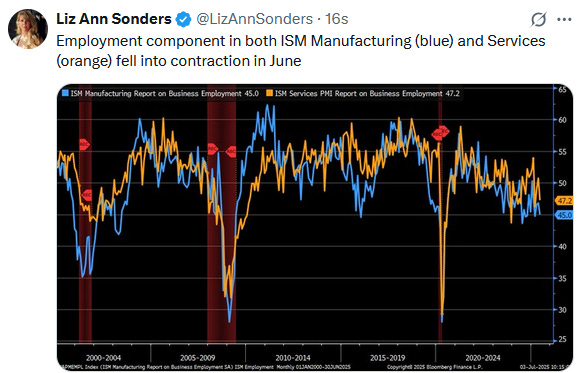Hidden within a Bloomberg article published over the July 4th weekend was the following quote alluding to the possibility that Treasury Secretary Scott Bessent could simultaneously replace Jerome Powell as the Fed Chair, while continuing to serve as the Treasury Secretary.
The president said Tuesday he has “two or three top choices” to potentially succeed Powell, but declined to name them. In recent weeks, Trump’s advisers have even discussed with him the possibility that Scott Bessent could simultaneously serve as Treasury secretary and Fed chair, according to people familiar with the matter. Such a move would be unprecedented since the two roles were separated in 1935, in legislation aimed at giving the Fed a measure of independence.
The White House denies the news, but the authors claim it comes from credible sources. Further, Bessent has made it clear that he will support the President in any way necessary.
Such a decision would be unprecedented. Notably, the Federal Reserve Act states that Fed members must “devote their entire time to the business of the Board.” Assuming Trump were to nominate Bessent to be Fed Chair and he were to remain at Treasury, and legal roadblocks were avoided, the market would likely take a bullish stance on the announcement. For starters, the markets seem to respect Bessent. Moreover, he has on numerous occasions said interest rates are too high.
The problem with the dual mandate is the competing interests of the Fed and the Treasury. For instance, if Bessent were to manage the Fed and the Treasury, he could lower interest rates to reduce the Treasury’s funding costs. However, this raises the question of whether Treasury funding costs take precedence over the impact of interest rates on the economy and inflation.
What To Watch Today
Earnings
No earnings releases today
Economy
Market Trading Update
As we noted yesterday, the risk of a pullback had risen sharply last week.
“With the S&P 500 breaking out to new highs but doing so on narrow participation and stretched technicals, now is the time to focus on disciplined execution, thoughtful asset rotation, and proactive risk control.”
We also reiterated that point yesterday morning during the Real Investment Show, where we discussed the sharp increase in speculative activity, investor positioning, and sentiment. As is always the case, when bullish sentiment and positioning reach more extreme levels, the risk of a pullback increases.
As we stated in that discussion, overbought conditions can remain overbought for some time, and simultaneously, it does NOT mean a sharp correction is imminent. Markets can correct overbought conditions through either a price correction or time.
However, with the market deviating above the 50 and 200-DMA, a pullback to previous resistance levels becomes increasingly probable. As shown, a pullback to last resistance at all-time highs would entail about a 2% decline from recent highs. A drawdown to the 50-DMA, which will intersect with previous support, would be roughly 5%. Such a corrective process would likely resolve most of the short-term overbought conditions, allowing for a better entry point to increase equity exposure.
To reiterate from yesterday’s commentary:
Raise cash allocations modestly to take advantage of potential pullbacks in late July or August.
Utilize trailing stop-losses on aggressive trades, particularly in leveraged ETFs or speculative names that have already seen sharp moves.
Avoid overexposure to crowded trades, especially single-stock themes and high-beta names vulnerable to profit-taking.
Monitor macro developments, including Fed commentary, PCE inflation data, and geopolitical headlines, as catalysts for sentiment reversal.
That advice remains our best recommendation for now.
AI Agent
We are proud to announce that AI is now integrated into SimpleVisor. Our first AI release, with many more to come, is our AI Agent tool, available under the ‘Simple AI’ tab. The following description is on the site, as written by AI:
The “Agents – Dashboard” and “Agents – Symbols” pages employs AI agents mimicking famed investors’ approaches to investment. The system provides the financial metrics, financial data, financial news and other information as expected by the investor to carry out analysis to suggest what decision these investors would have taken given the current data. Agent decisions are also based on generic approaches using a Valuation, Fundamental, Sentiment and Technical styles of investing. Please note the AI Generated content note at the bottom of the page.
The Agent tool consists of two components. The first tab is the Agents Dashboard. It provides a summary of how nine famed investors and four traditional investment techniques would view individual stocks. The first graphic below shows the summary. We clicked on Ben Graham’s bullish stocks, and the list of stocks he might be bullish on appeared on the right side of the screen. The second tab- Agents – Symbol, allows us to focus on individual S&P 500 stocks. This page enables us to understand why investors are bullish or bearish on a particular stock and the rationale behind their stance. Note that the confidence level provides feedback on the level of confidence the AI thinks the investor would have in their bullish or bearish decision.
The Bull Market Is Alive And Well
The bull market is alive and well, even amid widespread talk of the “death of U.S. exceptionalism.” Early 2025 saw a sharp shift in investor sentiment. Concerns over erratic trade policy, soaring debt, and weakening dollar pressure challenged America’s long-standing market dominance. Markets fell sharply in April and May, feeding a narrative of declining “US exceptionalism” as the leading technology stocks (known as the “Magnificent 7”) significantly underperformed the broader index.
The April sell-off began with President Trump’s sweeping “Liberation Day” tariff package on April 2. With nearly all sectors hit by tariffs, stocks plunged almost 20% from record highs, officially entering correction territory. To rationalize that decline, the media narratives ran wild after the preceding two years of 20% gains, with the most bearish headlines available. Reports from PineBridge, Standard Chartered, and iA Global Asset Management suggested the end of U.S. exceptionalism as global fund flows shifted. Even Societe Generale’s Alain Bokobza warned that fading confidence could drive a prolonged rotation out of U.S. stocks.
Tweet of the Day
“Want to achieve better long-term success in managing your portfolio? Here are our 15-trading rules for managing market risks.”










